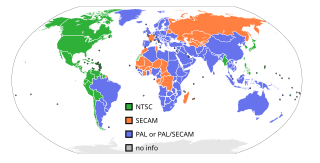 W
WThe Advanced Television Systems Committee (ATSC) is an international, nonprofit organization developing technical standards for digital terrestrial television and data broadcasting. ATSC's 120-plus member organizations represent the broadcast, broadcast equipment, motion picture, consumer electronics, computer, cable, satellite and semiconductor industries.
 W
WD2-MAC is a satellite television transmission standard, a member of Multiplexed Analogue Components family. It was created to solve D-MAC's bandwidth problem on European cable systems.D2-MAC uses half the data rate of D-MAC (10.125 Mbit/s) D2-MAC has a reduced vision bandwidth, about 1/2 that of D-MAC. D2-MAC retains most of the quality of a D-MAC signal—but consumes only 5 MHz of bandwidth.
 W
WDigital Video Broadcasting (DVB) is a set of international open standards for digital television. DVB standards are maintained by the DVB Project, an international industry consortium, and are published by a Joint Technical Committee (JTC) of the European Telecommunications Standards Institute (ETSI), European Committee for Electrotechnical Standardization (CENELEC) and European Broadcasting Union (EBU).
 W
WDigital Visual Interface (DVI) is a video display interface developed by the Digital Display Working Group (DDWG). The digital interface is used to connect a video source, such as a video display controller, to a display device, such as a computer monitor. It was developed with the intention of creating an industry standard for the transfer of digital video content.
 W
WDigital Video Broadcasting - Satellite - Second Generation (DVB-S2) is a digital television broadcast standard that has been designed as a successor for the popular DVB-S system. It was developed in 2003 by the Digital Video Broadcasting Project, an international industry consortium, and ratified by ETSI in March 2005. The standard is based on, and improves upon DVB-S and the electronic news-gathering system, used by mobile units for sending sounds and images from remote locations worldwide back to their home television stations.
 W
WHDMI is a proprietary audio/video interface for transmitting uncompressed video data and compressed or uncompressed digital audio data from an HDMI-compliant source device, such as a display controller, to a compatible computer monitor, video projector, digital television, or digital audio device. HDMI is a digital replacement for analog video standards.
 W
WMultiplexed analogue components (MAC) was a satellite television transmission standard, originally proposed for use on a Europe-wide terrestrial HDTV system, although it was never used terrestrially.
 W
WThe abbreviation NTSC can refer to the National Television System Committee, which developed the analog television color system that was introduced in North America in 1954 and stayed in use until digital conversion. NTSC is also commonly considered to be an abbreviation for the National Television Standards Committee, a subset of the National Television System Committee that was responsible for producing the detailed technical specifications for the transmission standard. It is one of three major analog color television standards, the others being PAL and SECAM.
 W
WPhase Alternating Line (PAL) is a colour encoding system for analogue television used in broadcast television systems in most countries broadcasting at 625-line / 50 field per second (576i). It was one of three major analogue colour television standards, the others being NTSC and SECAM.
 W
WPAL-M is the analog TV system used in Brazil since February 19, 1972. At that time, Brazil was the first South American country to broadcast in color. Color TV broadcast began on February 19, 1972, when the TV networks Globo and Bandeirantes transmitted the Caxias do Sul Grape Festival. Transition from black and white to colour was not complete until 1978. Two years later, in 1980, colour broadcast nationwide in Brazil was commonplace.
 W
WITU-R Recommendation BT.2020, more commonly known by the abbreviations Rec. 2020 or BT.2020, defines various aspects of ultra-high-definition television (UHDTV) with standard dynamic range (SDR) and wide color gamut (WCG), including picture resolutions, frame rates with progressive scan, bit depths, color primaries, RGB and luma-chroma color representations, chroma subsamplings, and an opto-electronic transfer function. The first version of Rec. 2020 was posted on the International Telecommunication Union (ITU) website on August 23, 2012, and two further editions have been published since then. It is expanded in several ways by Rec. 2100.
 W
WSECAM, also written SÉCAM, is an analog color television system first used in France. It was one of three major color television standards, the others being PAL and NTSC.